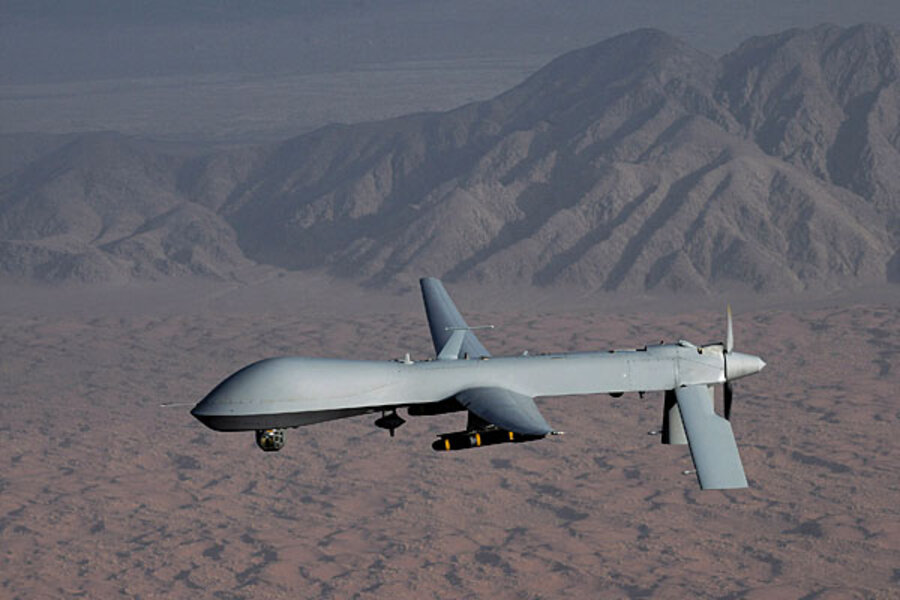Can drone strikes target US citizens? Critics say rules are vague.
Loading...
| Washington
A newly-leaked Justice Department memo detailing Obama administration rules for drone strikes on terrorists who are US citizens is drawing criticism Tuesday from across the political spectrum. It’s sure to be a central topic in the Senate on Thursday, when White House official John Brennan, who’s helped run the drone program, faces questions in his nomination hearing to be the next director of the CIA.
The central aspect of the memo that critics find troubling is its vagueness. The document outlines loose definitions of which citizens qualify as top terrorists, the circumstances under which they pose an “imminent” threat to the US, and when it’s not feasible to simply capture them.
“The takeaway is that the Obama administration took a process that is supposed to constrain the president within the law’s confines ... and then qualified those constraints so drastically that it would be more honest to acknowledge that neither imminence nor infeasible capture are really required,” writes Conor Friedersdorf of the Atlantic, a longtime opponent of the secret drone program.
First, the basics: the 16-page memo was obtained by NBC News and published on its website. It appears to be an unclassified Justice paper summarizing a longer, classified Office of Legal Counsel official finding on when it is – and isn’t – legal for US security officials to target US citizens suspected of working with Al Qaeda.
That classified memo, in turn, was drawn up prior to the 2011 drone strike in Yemen that killed Anwar al-Awlaki, a radical Muslim cleric born in New Mexico.
The paper obtained by NBC was apparently meant to be used to brief members of Congress. It outlines a three-part test for when US citizens might end up in their own nation’s cross-hairs.
First, they must be senior members of Al Qaeda. Second, they must pose an imminent threat of violent attack against the US. Third, it must be infeasible for US or allied forces to capture the individual in question.
The catch here is that when it comes to defining these terms, “the government is using its own dictionary,” according to Margaret Hartmann of New York Magazine’s Daily Intelligencer blog.
All that’s required, under the memo’s wording, is for a well-informed top official of the US government to decide that the person in question is a top terrorist. As for “imminent,” that does not mean “about to happen” in this case. It means only that the alleged terrorist must have recently been involved in activities posing a threat of violent attack and that there is no evidence they’ve renounced those activities.
Waiting to attack until a terrorist act is actually about to occur would be waiting too long, according to the memo. The US might not have time to defend itself, since top terrorists may make themselves scarce in the days and weeks before an attack is supposed to occur.
“The United States is likely to have only a limited window of opportunity within which to defend Americans in a manner that has both a high likelihood of success and sufficiently reduces the probabilities of civilian casualties,” reads the memo.
As for mounting an attempt to capture the person in question, that’s deemed “infeasible” if it might result in harm to US or allied forces.
The memo sparked a rare moment of bipartisanship in US political discourse, as some on both sides of the aisle reacted the same way to its provisions: with alarm.
At the right-leaning blog Hot Air, for instance, Ed Morrissey writes that “this memo ... basically gives the government carte blanche to target Americans in whatever it considers to be the battlefield for almost any kind of ‘threat’ it imagines.”
Other conservatives noted that the memo could well have been drawn up by the administration of George W. Bush.
Meanwhile, the American Civil Liberties Union declared the paper a “disturbing document.”
“It summarizes in cold legal terms a stunning overreach of executive authority – the claimed power to declare Americans a threat and kill them far from a recognized battlefield and without any judicial involvement before or after the fact,” said Hina Shamsi, director of the ACLU’s National Security Project, in a statement.
The US use of armed drones as the sharp point of its war against Al Qaeda was already sure to come up Thursday when John Brennan, Obama’s chief counterterrorism advisor, sits before the Senate Intelligence Committee.
White House officials have described Brennan as a restraint on the drone program, and said he’s eager to get the CIA out of the drone business by transferring it to the US military. They defend the use of drones as a responsible and limited effort that reduces both US casualties and collateral damage, while inflicting notable damage on America’s adversaries.
But the scope of US targeted killings – some 3,500 over the years, in an estimated 420 strikes, according to the Council on Foreign Relations – is so large that for some members of Congress simply shifting responsibility for the program may not be enough.
“We’ve shifted from major boots on the ground to an entirely secret operation in which not even the American people understand the costs or strategic benefit to what is being carried out in their name,” said Sarah Holewinski, executive director of the Center for Civilians in Conflict during a CFR media conference call on Feb. 4.








